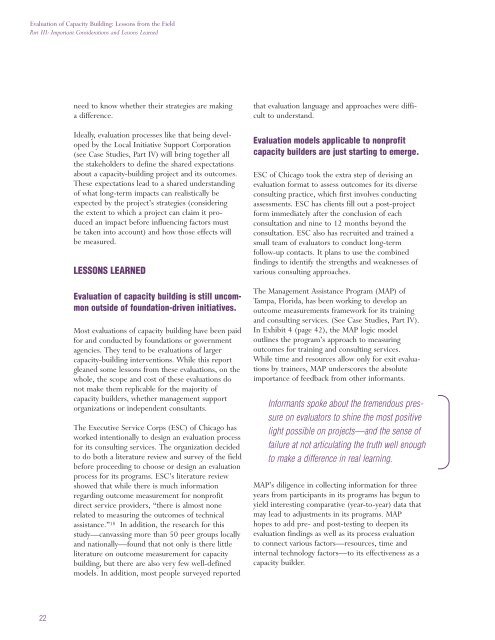Lessons from the Field - Seer Consulting
Lessons from the Field - Seer Consulting
Lessons from the Field - Seer Consulting
Create successful ePaper yourself
Turn your PDF publications into a flip-book with our unique Google optimized e-Paper software.
Evaluation of Capacity Building: <strong>Lessons</strong> <strong>from</strong> <strong>the</strong> <strong>Field</strong><br />
Part III: Important Considerations and <strong>Lessons</strong> Learned<br />
22<br />
need to know whe<strong>the</strong>r <strong>the</strong>ir strategies are making<br />
a difference.<br />
Ideally, evaluation processes like that being developed<br />
by <strong>the</strong> Local Initiative Support Corporation<br />
(see Case Studies, Part IV) will bring toge<strong>the</strong>r all<br />
<strong>the</strong> stakeholders to define <strong>the</strong> shared expectations<br />
about a capacity-building project and its outcomes.<br />
These expectations lead to a shared understanding<br />
of what long-term impacts can realistically be<br />
expected by <strong>the</strong> project’s strategies (considering<br />
<strong>the</strong> extent to which a project can claim it produced<br />
an impact before influencing factors must<br />
be taken into account) and how those effects will<br />
be measured.<br />
LESSONS LEARNED<br />
Evaluation of capacity building is still uncommon<br />
outside of foundation-driven initiatives.<br />
Most evaluations of capacity building have been paid<br />
for and conducted by foundations or government<br />
agencies. They tend to be evaluations of larger<br />
capacity-building interventions. While this report<br />
gleaned some lessons <strong>from</strong> <strong>the</strong>se evaluations, on <strong>the</strong><br />
whole, <strong>the</strong> scope and cost of <strong>the</strong>se evaluations do<br />
not make <strong>the</strong>m replicable for <strong>the</strong> majority of<br />
capacity builders, whe<strong>the</strong>r management support<br />
organizations or independent consultants.<br />
The Executive Service Corps (ESC) of Chicago has<br />
worked intentionally to design an evaluation process<br />
for its consulting services. The organization decided<br />
to do both a literature review and survey of <strong>the</strong> field<br />
before proceeding to choose or design an evaluation<br />
process for its programs. ESC’s literature review<br />
showed that while <strong>the</strong>re is much information<br />
regarding outcome measurement for nonprofit<br />
direct service providers, “<strong>the</strong>re is almost none<br />
related to measuring <strong>the</strong> outcomes of technical<br />
assistance.” 18 In addition, <strong>the</strong> research for this<br />
study—canvassing more than 50 peer groups locally<br />
and nationally—found that not only is <strong>the</strong>re little<br />
literature on outcome measurement for capacity<br />
building, but <strong>the</strong>re are also very few well-defined<br />
models. In addition, most people surveyed reported<br />
that evaluation language and approaches were difficult<br />
to understand.<br />
Evaluation models applicable to nonprofit<br />
capacity builders are just starting to emerge.<br />
ESC of Chicago took <strong>the</strong> extra step of devising an<br />
evaluation format to assess outcomes for its diverse<br />
consulting practice, which first involves conducting<br />
assessments. ESC has clients fill out a post-project<br />
form immediately after <strong>the</strong> conclusion of each<br />
consultation and nine to 12 months beyond <strong>the</strong><br />
consultation. ESC also has recruited and trained a<br />
small team of evaluators to conduct long-term<br />
follow-up contacts. It plans to use <strong>the</strong> combined<br />
findings to identify <strong>the</strong> strengths and weaknesses of<br />
various consulting approaches.<br />
The Management Assistance Program (MAP) of<br />
Tampa, Florida, has been working to develop an<br />
outcome measurements framework for its training<br />
and consulting services. (See Case Studies, Part IV).<br />
In Exhibit 4 (page 42), <strong>the</strong> MAP logic model<br />
outlines <strong>the</strong> program’s approach to measuring<br />
outcomes for training and consulting services.<br />
While time and resources allow only for exit evaluations<br />
by trainees, MAP underscores <strong>the</strong> absolute<br />
importance of feedback <strong>from</strong> o<strong>the</strong>r informants.<br />
Informants spoke about <strong>the</strong> tremendous pressure<br />
on evaluators to shine <strong>the</strong> most positive<br />
light possible on projects—and <strong>the</strong> sense of<br />
failure at not articulating <strong>the</strong> truth well enough<br />
to make a difference in real learning.<br />
MAP’s diligence in collecting information for three<br />
years <strong>from</strong> participants in its programs has begun to<br />
yield interesting comparative (year-to-year) data that<br />
may lead to adjustments in its programs. MAP<br />
hopes to add pre- and post-testing to deepen its<br />
evaluation findings as well as its process evaluation<br />
to connect various factors—resources, time and<br />
internal technology factors—to its effectiveness as a<br />
capacity builder.


